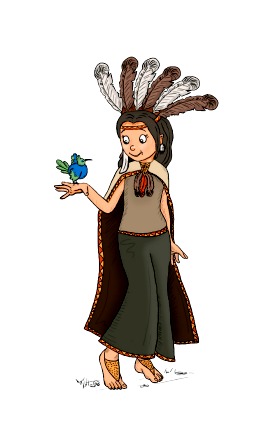Start a Hummingbird Garden!
The urge to start your own hummingbird garden is difficult to ignore when spring blossoms into summer, draping the world in lush greens and vibrant floral hues. I realize if you’re an amateur gardener this can be an appealing yet daunting challenge.
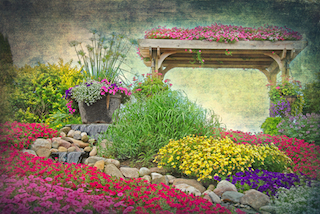
Have no fear! You can successfully plant a garden with the visual cues of bright red, orange, white, purple, and pink that attract our tiny friends.
Once you know how to choose the right type of plants, you’ll feel the confidence to get started.
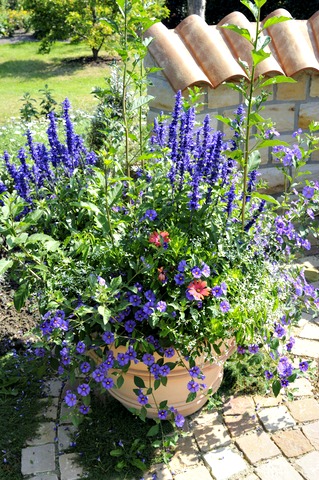 Blue/Violet Salvia and Petunias in Pot |
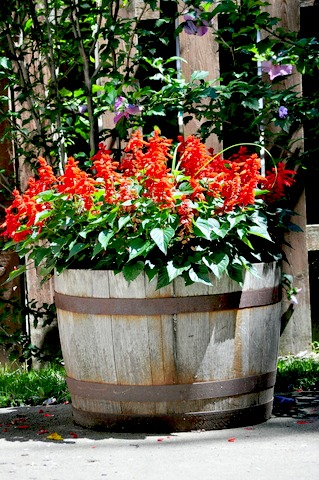 Red Salvia in Whiskey Barrell |
If you are a beginner gardener, or even perhaps you don't have the space or the time for a traditional garden, may I suggest a container garden?
I started out this way, and my containers burst forth with lush begonias and with the red salvia.
So easy to grow, and you can plant the salvia alone, or mixed with other flowers.
Plant the salvia in the middle or along a backside, then add lower growing flowers next, like begonias or fuchsia.
Finally for the outer edge plant petunias or impatiens to spill over the edges.
So pretty and easy! Hang up a feeder or two somewhere near your flowers, and perhaps also a couple of hanging flowers in baskets!
Hummingbirds will love the tasty variety you provide!
Vibrant Hummingbird Garden Requires Proper Plants & Flowers
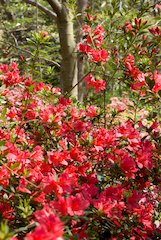
Since hummingbirds can’t smell they operate purely on the basis of visual cues.
Bright reds and oranges are very attractive to them.
Flowers with a long, tubular shape are also especially favored, as they produce a fair amount of nectar and are particularly well suited to the birds’ long, tapering beaks.
A great way to start a garden is with shrubs such as azaleas and rhododendrons.
Other good choices in this category are butterfly bush, cape honeysuckle, lantana, manzanita, and weigela.
These hummingbird garden plants grow well in good light and form a delightful border when used for hedging.
As well, there are many species of flora that attract hummingbirds, including columbines, delphiniums, cardinals, petunias, foxgloves, penstemons, impatiens, rhododendrons, and fuchsias.
Most of these flowers grow well from seed, but it’s best to begin with established seedlings purchased from a reputable nursery.
The choice of which flowers to plant depends primarily on personal tastes.
For instance, while rhododendron bushes do attract hummingbirds, the leaves and flowers can be toxic to children. The same is true of other plant species such as foxgloves and delphiniums.
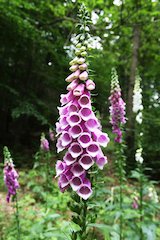
Planning & Getting Started
It’s important when planning your garden to leave plenty of room between flowers and bushes so birds can easily maneuver amongst them.
Clear your planting area of weeds and use a hoe to break up any remaining root structures.
Add some organic compost to the soil and dig it through the planting area. You want to end up with a nice, loose mix of soil and compost.
Use established starters from your local nursery.
Make sure to leave at least a foot of space between the plants. Crowding starters too closely to one another leaves them weak and unhealthy. The bushes will grow out and the space will eventually fill up.
Flowers that bush out well like verbena and fuchsias are very attractive when planted in hanging pots.
Other flower species such as impatiens, petunias, and penstemons can be grown anywhere in your garden depending upon the light conditions. Impatiens, for instance, grow well in shaded conditions.
Some species like foxgloves and delphiniums grow very tall, and are ideal for the back of a flowerbed or against your house. Species such as petunias and fuchsias look gorgeous in planters along a deck.
Think About Shelter
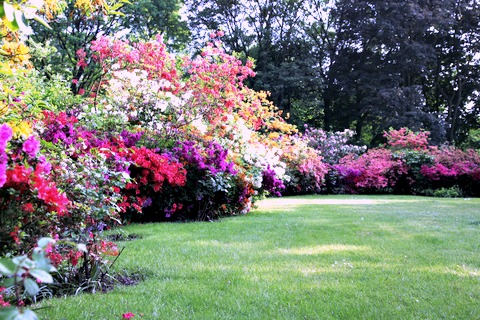
As you plan understand that hummingbirds like to find places that provide cover when they rest between their feeding sessions.
Plan your garden to sit up against a fence, at the edge of a forest, or close to shrubbery.
This helps your colorful visitors not only feel as if they have cover, or shelter, but can also be protective against strong winds.
If you shape your garden like a horseshoe this can provide shelter for feeding no matter which way the wind may be blowing.
When your hummingbirds do seek shelter in between feeding keep in mind how they like to perch on bare twigs and dead snags.
For their nests they love slim branches that slope downward. You’ll usually find these types of branches at the borders of your garden. Think about this when trimming your bushes.
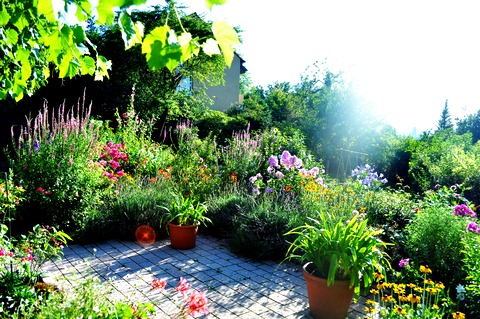
Think About Diversity
You’ll see far more hummingbirds in your garden if you provide plenty of options.
As you plan out your garden think about using a diversity of shrubs and trees, weedy or natural edges or areas, formal as well as informal garden ideas, a wildflower meadow and whatever lawn area you may want.
The more diversity you provide the more activity you’ll experience!
With some creativity and effort you’ll find it’s not hard to start a hummingbird garden that becomes the envy of your neighborhood.
Subscribe to my updates!
Hummingbirds > Hummingbird Garden






